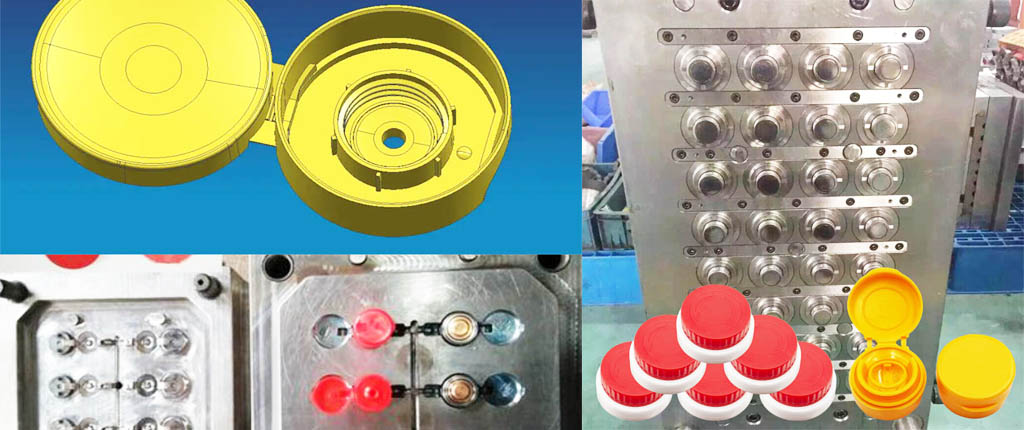How to do high quality plastic bottle cap molds? In the realm of plastic injection moulding manufacturing, the quality of molds plays a pivotal role in determining the success of the final product. When it comes to plastic bottle caps, achieving high quality molds is not just a process; it’s an art. This blog will guide you through the steps to master the creation of top-notch plastic bottle cap molds.
Table of Contents
ToggleHow to do high quality plastic bottle cap molds
When making high-quality plastic bottle cap molds, key steps and considerations include:
1. Design of plastic bottle cap molds
Use CAD software to create detailed and accurate 3D designs that ensure compliance with required cap specifications.
Pay attention to the dimensions, tolerances and features of the mold.
2. Steel Selection
Choose high-quality and durable materials such as tool steel (e.g. S136 or H13), stainless steel or aluminum, depending on production volume and requirements.
Consider factors such as wear resistance, thermal conductivity and ease of processing.
3. Processing
Machining using CNC machines for precision and accuracy.
Pay attention to the surface finish, which will affect the final appearance of the cap.
4. Heat Treatment
Heat treatment is performed to increase the hardness and durability of the mold material, depending on the steel grade selected.
5. Surface Coating
Coating or treating the mold surface to improve release properties and reduce friction. Common coatings include nitriding or chromium plating.
6. Exhaust
Make sure the mold has proper ventilation to allow gases during the injection molding process to escape and prevent defects such as bubbles or burn marks on the cap.
7. Injection molding parameters
Optimize injection molding parameters such as temperature, pressure and cooling time to obtain the desired cap quality. This may require iterative adjustments based on the pilot process.
8. QC of plastic bottle cap molds
Strict quality control processes are implemented to check formed caps for defects and compliance with dimensional and other quality standards.
Maintain and inspect molds regularly and resolve any issues promptly.
9. Documentation
Keep detailed documentation of the mold design, manufacturing process, and any adjustments during production. This is very valuable for troubleshooting and future reference.
9. Keep Improve
Regularly evaluate production processes and mold performance, and implement continuous improvement measures to improve efficiency and quality.

Innovative Breakthroughs in Plastic Bottle Cap Mold Technology
Mr. Li Keping, an expert from Joffet in Italy, specializes in the intricate field of plastic bottle cap molds. Despite the seemingly straightforward nature of plastic bottle cap production, crafting the molds requires a high level of professional expertise. Mr. Li is renowned for his work in planning and manufacturing multi-cavity, high-precision, hot-runner injection molds.
In 2000, Mr. Li achieved a significant milestone by developing a 64-cavity rapid prototyping cap mold. This innovative mold set a world record for the fastest opening and closing cycle of cavity-grade bottle cap molds, completing the process in just 3 seconds on the Nestal rapid injection molding machine.
In response to the European market’s focus on reducing bottle cap weight and increasing production rates while maintaining physical functionality, Joffet introduced the MIVA series caps. For instance, the MIWAL3P, with a diameter of 28mm, weighs only 1.5~1.6g—1g lighter than traditional PET bottle plastic caps. This cap requires just a 90° rotation to open, featuring low opening torque and suitability for individuals of all ages.
Joffet has supplied 7 sets of the 64-cavity cap mold to Wahaha Group, showcasing their commitment to meeting market demands. Additionally, Joffet Company has patented a non-rotating double-material injection mold, streamlining the production of bottle caps with pads. This innovation significantly reduces equipment investment, as it allows the easy integration of an injection unit into existing machines for the production of caps with pads.
Injection molding and pressing bottle caps are distinct processes. Injection molding offers flexibility in style design through the purchase of diverse molds, allowing for the creation of intricate caps. However, the associated mold costs are high. On the other hand, pressed bottle caps are a more cost-effective alternative.
In conclusion, it is important to note that the specific steps for making a high-quality plastic bottle cap mold may vary depending on project requirements and the type of plastic used. Consulting with experienced mold designers and manufacturers can provide valuable insights tailored to your needs.
